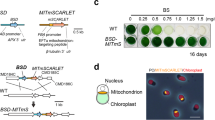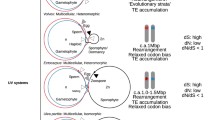Abstract
In the sexual reproduction of the green alga Closterium ehrenbergii, two sexually competent cells that are morphologically indistinguishable from the vegetative cells first come close to each other to form a sexually interacting pair. Each then divides into two gametangial cells. Isogamous conjugation occurs between nonsister gametangial cells of the two resulting pairs. With unusual selfing clones derived from a certain cross of heterothallic strains, we dissected apart a pair of gametangial cells that had already been united together by a delicate transparent tube, into which each gametangial cell was going to develop its conjugation papilla. In spite of such a degree of differentiation, when each was cultured in fresh medium, individual gametangial cells could dedifferentiate into vegetative cells and form subclones. By crossing such subclones with standard stable heterothallic mating-type strains, we show that each selfing clone of this alga actually produces both stable mt + and stable mt - cells, in addition to unstable mt - cells with selfing potency, during its mitotic vegetative growth. Although the selfing in C. ehrenbergii studied here differs in certain points from true homothallism, the results of the present study provide insight into how homothallism might have evolved from heterothallism.
Similar content being viewed by others
References
Charlesworth B (1983) Mating types and uniparental transmission of chloroplast genes. Nature 304:211
Ebersold W T (1967) Chlamydomonas reinhardtii: heterozygous diploid strains. Science 157:447–449
Egel R (1976) Rearrangements at the mating type locus in fission yeast. Mol Gen Genet 148:149–158
Egel R (1989) Mating-type genes, meiosis, and sporulation. In: Nasim A, Young P, Johnson BF (eds) Molecular biology of the fission yeast. Academic Press, London, pp 31–73
Harashima S, Nogi Y, Oshima Y (1974) The genetic system controlling homothallism in Saccharomyces yeasts. Genetics 77:639–650
Herskowits L (1989) A regulatory hierachy for cell speciallization in yeast. Nature 342:749–757
Hoekstra RF (1987) The evolution of sexes. In: Stearns SC (ed) The evolution of sex and its consequences. Birkhauser, Basel, pp 59–91
Hogetsu T, Yokoyama M (1979) Light, a nitrogen-depleted and cell-cell interaction in the conjugation process of Closterium ehrenbergii Meneghini. Plant Cell Physiol 20:811–817
Ichimura T (1981) Mating types and reproductive isolation in Closterium ehrenbergii Meneghini. Bot Mag Tokyo 94:325–334
Ichimura T (1983) Hybrid inviability and predominant survival of mating type minus progeny in laboratory crosses between two closely related mating groups of Closterium ehrenbergii. Evolution 37:252–260
Ichimura T, Kasai F (1984) Time-lapse analyses of sexual reproduction in Closterium ehrenbergii (Conjugatophyceae). J Phycol 20:258–265
Ichimura T, Kasai F (1987) Time-lapse analyses of sexual isolation between two closely related mating groups of the Closterium ehrenbergii species complex (Chlorophyta). J Phycol 23:523–534
Ichimura T, Kasai F (1990a) Genome differentiation in speciation of desmids (Chlorophyta). Jpn J Phycol 37:305–319
Ichimura T, Kasai F (1990b) Mating systems and speciation in haplontic unicellular algae, desmids. In: Kawano S (ed) Biological approaches and evolutionary trends in plants. Academic Press, London, pp 195–201
Kasai F, Ichimura T (1987) Stable diploids from intragroup zygospores of Closterium ehrenbergii Menegh. (Conjugatopyceae). J Phycol 23:344–351
Kasai F, Ichimura T (1990) A sex determining mechanism in the Closterium ehrenbergii (Chlorophyta) species complex. J Phycol 26:195–201
Lewin RA (1954) Sex in unicellular algae. In: Wenrich DH (ed) Sex in microorganisms. American Association for the Advancement of Science, Washington, D.C., pp 100–133
Lewin RA (1976) The genetics of algae. Blackwell, Oxford
Lippert BE (1967) Sexual reproduction in Closterium moniliferum and Cl. ehrenbergii. J Phycol 3:182–198
VanWinkle-Swift KP, Aubert B (1983) Uniparental inheritance in a homothallic alga. Nature 303:167–169
VanWinkle-Swift KP, Hahn J-H (1986) The search for mating-type-limited genes in the homothallic alga Chlamydomonas monoica. Genetics 113:601–619
VanWinkle-Swift KP, Thuerauf DJ (1991) The unusual sexual preferences of a Chlamydomonas mutant may provide insight into mating-type evolution. Genetics 127:103–115
Author information
Authors and Affiliations
Rights and permissions
About this article
Cite this article
Ichimura, T., Kasai, F. Dissection of conjugants and mating type plus and minus cells in selfing clones of the isogamous green alga Closterium ehrenbergii . Sexual Plant Reprod 8, 44–48 (1995). https://doi.org/10.1007/BF00228762
Received:
Accepted:
Issue Date:
DOI: https://doi.org/10.1007/BF00228762




